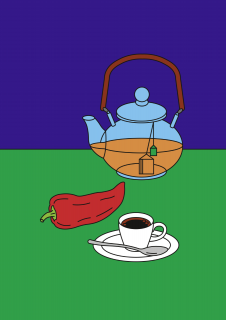Menschen
On beads, coffee and tea
Why do the British drink so much tea, whereas Italy is known for espresso? And are so many people in India really IT gurus, or is that a cliché? One thing is certain: when it comes to different nationalities, traits are usually shaped by trade.
When you think of Venice, you imagine stone bridges arching above canals, narrow gondolas, masks with beaked noses – and, of course, brightly-colored glass beads from Murano. Strung together as bracelets and necklaces, the spheres with their tiny blossoms are a popular souvenir of the Venetian archipelago. Murano glass has been associated with Venice at least since the Middle Ages. Back then, Venice had all the glassmaking kilns in the region transferred to the island of Murano. When, between the fifteenth and eighteenth centuries, Europeans began to engage with India, Africa and the Americas, the beautiful beads found their way all around the world. The people the traders encountered on these alien continents had no interest in European currencies. They far preferred to barter using decorative goods and trinkets. For this reason, seafaring merchants placed orders for Murano glass beads and traded them during their odysseys – for spices, ivory, palm oil and even slaves. The glassworks in Murano produced up to one million beads a year; Christopher Columbus allegedly presented some to his hosts when he reached San Salvador in Central America. And, over time, what we now refer to as Venetian glass became known as “trading beads.”
Commerce drives national preferences
During his voyage to the Americas, Christopher Columbus was the first European to encounter paprika. Some 75 years later, the Hungarian noblewoman Margit Széchy planted it in her garden, and dubbed it “red Turkish pepper.” After all, the Turks had been the first to import the spice – doing so in 1526 after their defeat of the Hungarians in the Battle of Mohács and their conquest of large parts of the Kingdoms of Hungary and Croatia. Today paprika, the Puszta and the Danube all help to define the country’s national character. The British partiality towards tea is similarly rooted in colonial commerce. First cultivated for medicinal purposes 5,000 years ago in China, it made its way to Europe – or, more precisely, to Amsterdam – with the Dutch East India Company in the early seventeenth century. It took a further 50 or so years for it to reach England – prompted by the marriage between the heir to the British throne, Charles II, and the Portuguese princess Catharine of Braganza. The court in Portugal had long been steeped in the tea tradition by virtue of the Portuguese colony of Macau. As a result, tea became part of the infanta’s dowry, and she regularly invited upper-class women to “tea time” where they discussed all the latest gossip. At some point Britain started importing more and more tea from its colony India, and the rising volumes led to a commensurate drop in price. With time, even the working classes could afford a “cuppa,” and tea supplanted beer – which had also been a breakfast drink served warm, sugared and spiced with nutmeg – as the national beverage. It is surprising to learn that, despite England and tea being so closely linked, the country only ranks eighth in the global league of tea drinkers. It trails in the wake of Turkey, Brazil, China, Singapore, Russia, Sri Lanka and Hong Kong. A little-known statistic about Italy, THE coffee country per se, strikes a similarly unexpected chord. In a worldwide survey on the per capita consumption of coffee, Italy came in close to the bottom. The fact that Italy evokes associations of black espresso and frothy cappuccino is due to the wanderlust of the physician and botanist Prospero Apini. In the sixteenth century, he accompanied a Venetian consul to Cairo where he saw a coffee plant. One of his pupils then ended up bringing the beans to Venice. The first shipload arrived at the port in the early seventeenth century; initially enjoyed by the islands’ aristocrats, the brew soon spread throughout Italy.
Blue jeans and Indian IT prowess
National identities are shaped not only by goods; certain skills and, of course, political decisions also factor into the image. The connection between India and the IT industry, for instance, is by no means a cliché, but rather the culmination of a long historic process. Following independence in 1947, the Prime Minister Jawaharlal Nehru adopted a national economic policy that was keyed closely to modern computer technology. On the one hand, he welcomed multinational manufacturers such as IBM into his country. And on the other, he encouraged the training of IT specialists by establishing elite universities such as the Indian Institute of Technology (IIT). So, by the 1970s, there were countless Indians who were skilled at programming and other IT applications. And very soon thereafter, software development was recognized as a new industry on the subcontinent. Global players, lured by the low cost of labor, established their own development centers in India. It remains to be seen how long the country can retain its competitive edge on the international stage. The next generation of IT specialists may well hail from Brazil, China, Poland – or another country with well-educated people willing to work for comparatively low wages. Like the actions of individuals, geographical features can also advance national characteristics. Cotton, cultivated in the United States, is the stuff blue jeans are made of. A nostalgic embodiment of the American lifestyle, these conjure up images of the lonesome cowboy on his loyal steed, or the gold diggers desperate to strike it rich. In today’s world, hardly anybody knows that the word “jeans” derives from the Italian city of Genoa: the cotton trousers were exported from there to the United States. Greece’s longstanding association with seafaring is an outcome of its location in the Eastern Mediterranean – and the 3,000 or more islands that it comprises. For centuries, these islands were only accessible by water, which led to the country with the blue-andwhite flag becoming a nation of mariners. Today Greek shipping companies can boast one of the world’s principal commercial fleets. And thanks to an exemption embedded in the country’s constitution, the companies pay virtually no taxes. Aristotle Onassis granted this exemption during the 1950s and there is no sign of it being revoked any time soon. All in all, national symbols often offer pointers to a country’s past or its geography. And despite many being the simple product of chance, they still succeed in surviving for centuries.
Carola Hoffmeister studied art history and literature. As a journalist and author, she is constantly traveling the big wide world.

Blue Jeans und indisches IT-Know-how
Aber nicht nur Handelsgüter prägen und symbolisieren Länder, auch bestimmte Fertigkeiten und natürlich politische Entscheidungen tragen zum Image eines Landes bei. Der Zusammenhang zwischen Indien und der IT-Branche etwa ist tatsächlich kein Klischee, sondern das Ergebnis einer langen historischen Entwicklung: Nach der Unabhängigkeit des Landes im Jahr 1947 setzte Ministerpräsident Jawaharlal Nehru bei der staatlichen Wirtschaftsplanung auf moderne Computertechnologie. Multinationalen Unternehmen wie IBM erteilte er die Erlaubnis, in Indien tätig zu werden, gleichzeitig stärkte er die Ausbildung von Ingenieuren und Ingenieurinnen durch die Gründung von Elitehochschulen wie dem Indian Institute of Technology (IIT). So gab es bereits in den 1970er Jahren viele indische Fachkräfte, die mit Programmierung und Informatik vertraut waren. Kurze Zeit später wurde die Softwareentwicklung auf dem Subkontinent als Industrie anerkannt, internationale Konzerne richteten aufgrund der niedrigen Lohnkosten eigene Softwareentwicklungszentren in Indien ein. Wie lange das Land seine Wettbewerbsvorteile gegenüber der internationalen Konkurrenz verteidigen kann, wird sich zeigen. Gut möglich jedoch, dass die nächste Generation von IT-Fachkräften aus Brasilien kommen wird, aus China, Polen oder einem anderen Land mit gut ausgebildeten Leuten, die für relativ niedrige Löhne arbeiten. Genauso wie das Handeln Einzelner fördern und prägen geografische Gegebenheiten Nationalsymbole. Amerikanische Baumwolle verkörpert über die aus ihr gefertigten Blue Jeans ein nostalgisches Lebensgefühl der USA – zum Beispiel das des einsamen Cowboys auf seinem Pferd oder des Goldgräbers auf der Suche nach dem großen Fund. Dabei spielt gar keine Rolle mehr, dass es eigentlich die italienische Stadt Genua war, die der Jeans ihren Namen gab – denn von dort aus wurden die Baumwollhosen in die USA
exportiert.
Dass Griechenland mit Seefahrt assoziiert wird, liegt wiederum an seiner Lage im östlichen Mittelmeer – und daran, dass zu Griechenland mehr als 3.000 Inseln gehören. Über Jahrhunderte hinweg waren sie ausschließlich über den Wasserweg erreichbar, und so entwickelte sich das Land mit der blau-weißen Flagge zur Seefahrernation. Heute besitzen griechische Reedereien eine der wichtigsten Handelsflotten weltweit – und zahlen in ihrem Heimatland dank einer Sonderregel in der griechischen Verfassung so gut wie keine Steuern. Dafür hat Aristoteles Onassis bereits in den 1950ern gesorgt. Und vermutlich wird sich daran auch nicht so schnell etwas ändern. So verweisen Nationalsymbole häufig in die Geschichte, in die Geografie und bisweilen auch auf Zufälle – manchmal über lange Zeiten hinweg.
Carola Hoffmeister hat Kunstgeschichte und Literaturwissenschaft studiert. Als Journalistin und Autorin zieht es sie immer wieder in die weite Welt.












